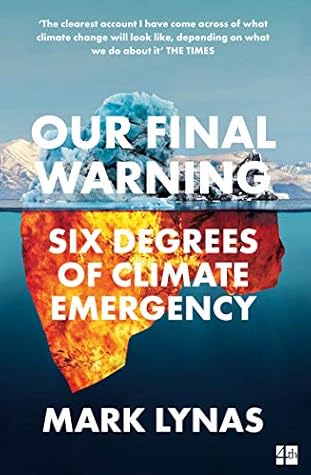More on this book
Kindle Notes & Highlights
by
Mark Lynas
Read between
December 31, 2021 - January 10, 2022
At three degrees I now believe that the stability of human civilisation will be seriously imperilled, while at four degrees a full-scale global collapse of human societies is probable, accompanied by a mass extinction of the biosphere that will be the worst on Earth for tens or even hundreds of millions of years. By five degrees we will see massive positive feedbacks coming into play, driving further warming and climate impacts so extreme that they will leave most of the globe biologically uninhabitable, with humans reduced to a precarious existence in small refuges. At six degrees we risk
...more
If we stay on the current business-as-usual trajectory, we could see two degrees as soon as the early 2030s, three degrees around mid-century, and four degrees by 2075 or so.
at some point in the two-degree world we will see the complete disappearance of Arctic sea ice, resulting in an ice-free North Pole for the first time for about three million years. It is already fairly likely that most people alive today who are middle-aged or younger will witness this event,
Climate models are virtually unanimous in associating lost Arctic sea ice with a strengthening of the hydrological cycle worldwide (floods, droughts and extreme rainfall) and a shifting of the equatorial rain bands.
Three entire cities of more than 100,000 residents – all in Russia – are built on areas that are currently continuous permafrost.
Unless humanity can somehow wave the magic wand of negative emissions, we do not therefore have a high chance of staying permanently in the two-degree world once the Arctic begins to melt. This additional greenhouse gas release from thawing permafrost will not happen instantly – it will take many decades to play out. But the ultimate destination is clear: unless curbed by carbon cuts, the Arctic permafrost carbon feedback is a shortcut to the three-degree world.
higher levels of CO2 make crops less nutritious. With atmospheric CO2 at 550 ppm, researchers reported in Nature Climate Change in 2018, many food crops will have protein, zinc and iron contents that are reduced by 3–17% compared with current conditions.
Researchers now suggest that we’ll be back in the Pliocene as soon as 2030 with current emissions trends.
In my view, worldwide food shortages are the most likely trigger of large-scale civilisational collapse in a three-degree world.
each tonne of CO2 emitted by fossil fuel users is responsible for eliminating 15 tonnes of glacier mass from the highest slopes of the Himalayas. It is a sobering thought, perhaps, for the climbers and trekkers visiting India and Nepal that their international flights are contributing measurably to the deglaciation of the mountains they love so much.


